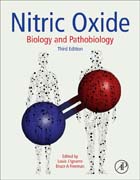
Nitric Oxide: Biology and Pathobiology, Third Edition provides information on nitric oxide, a signaling molecule of key importance for the cardiovascular system that regulates blood pressure and blood flow to different organs. With recent links to the role of nitric oxide in the expression of healthy benefits of controlled diet and aerobic exercise, and the reactions of nitric oxide that can impact cell signaling, this book provides a comprehensive resource during a time when increased research attention is being paid across the fields of biochemistry, chemistry, molecular biology, gene therapy, cell biology, immunology, pharmacology, neuroscience, and physiology. Includes perspectives from Jack Lancaster on the discovery of EDRF and nitric oxideProvides detailed coverage of the new gaseous signaling agents Features expanded coverage on the principles of biology, including nitric oxide synthases, nitrite and nitrate biology and pathobiology, and signaling mechanismsIncorporates expanded pathobiology coverage, including nitric oxide and cardiovascular function, obesity, diabetes, and erectile function/dysfunction INDICE: Section I. Chemical Biology 1. Determinants of Nitric Oxide Chemistry: Impact of Cell Signaling Processes 2. Nitric oxide redox biochemistry in lipid environments 3. Mechanisms and biological consequences of peroxynitrite-dependent protein oxidation and nitration 4. Systems Approaches to Unraveling Nitric Oxide Response Networks in Prokaryotes Section II. Principles of Biology A. Nitric Oxide Synthases 5. Uncoupling of endothelial NO synthase (eNOS) in cardiovascular disease and its pharmacological reversal 6. Tetrahydrobiopterin: An essential cofactor for Nitric Oxide Synthases and Amino Acid Hydroxylases 7. Regulation of the expression of inducible nitric oxide synthase 8. Molecular Regulation of Inducible Nitric Oxide Synthase B. Guanylate Cyclase and Cyclic GMP 9. Soluble Guanylate Cyclase: Allosteric Activation and Redox Regulation C. Nitric Oxide Signaling 10. Untargeted Discovery of NO-modified Proteins 11. Fatty Acid Transduction of Nitric Oxide Signaling: Cyclooxygenases, Lipoxygenases and Nitro-Fatty Acids 12. Nitric Oxide Signaling in Vascular Cells is Regulated through CD47 by Thrombospondin-1 13. The Regulation of Cell Energetics and Mitochondrial Signaling by Nitric Oxide D. Regulation of Nitric Oxide Production 14. Nitric oxide-asymmetric dimethylarginine system in endothelial cell senescence E. Nitric Oxide and Remodeling 15. The Role of Nitric Oxide in Apoptosis and Autophagy: Biochemical and Computational Studies F. Nitrite and Nitrate 16. NO formation from inorganic nitrate and nitrite 17. Mechanisms of nitrite reduction in ischemia in the cardiovascular system: therapeutic potential 18. Nitrite Therapy for Ischemic Syndromes 19. Nitrite and heme globins: Reaction mechanisms and physiological targets Section III. Principles of Pathobiology A. Nitric Oxide and Cardiovascular Function 20. Nitric Oxide in Vascular Damage and Regeneration 21. Free radicals as atherosclerotic risk-The relation of NO- 22. The role of oxidative stress in endothelial dysfunction and vascular inflammation B. Pathophysiological Mechanisms of Nitric Oxide 23. Nitric oxide, oxidative stress, immune response and critical care 24. Reactive Metabolites of Oxygen and Nitrogen in Liver Ischemia and Reperfusion Injury 25. Nitric oxide in airway inflammation 26. Novel therapeutic applications of nitric oxide (NO) in the inhibition of tumor malignancy and reversal of resistance
- ISBN: 978-0-12-804273-1
- Editorial: Academic Press
- Encuadernacion: Cartoné
- Páginas: 864
- Fecha Publicación: 01/03/2017
- Nº Volúmenes: 1
- Idioma: Inglés
